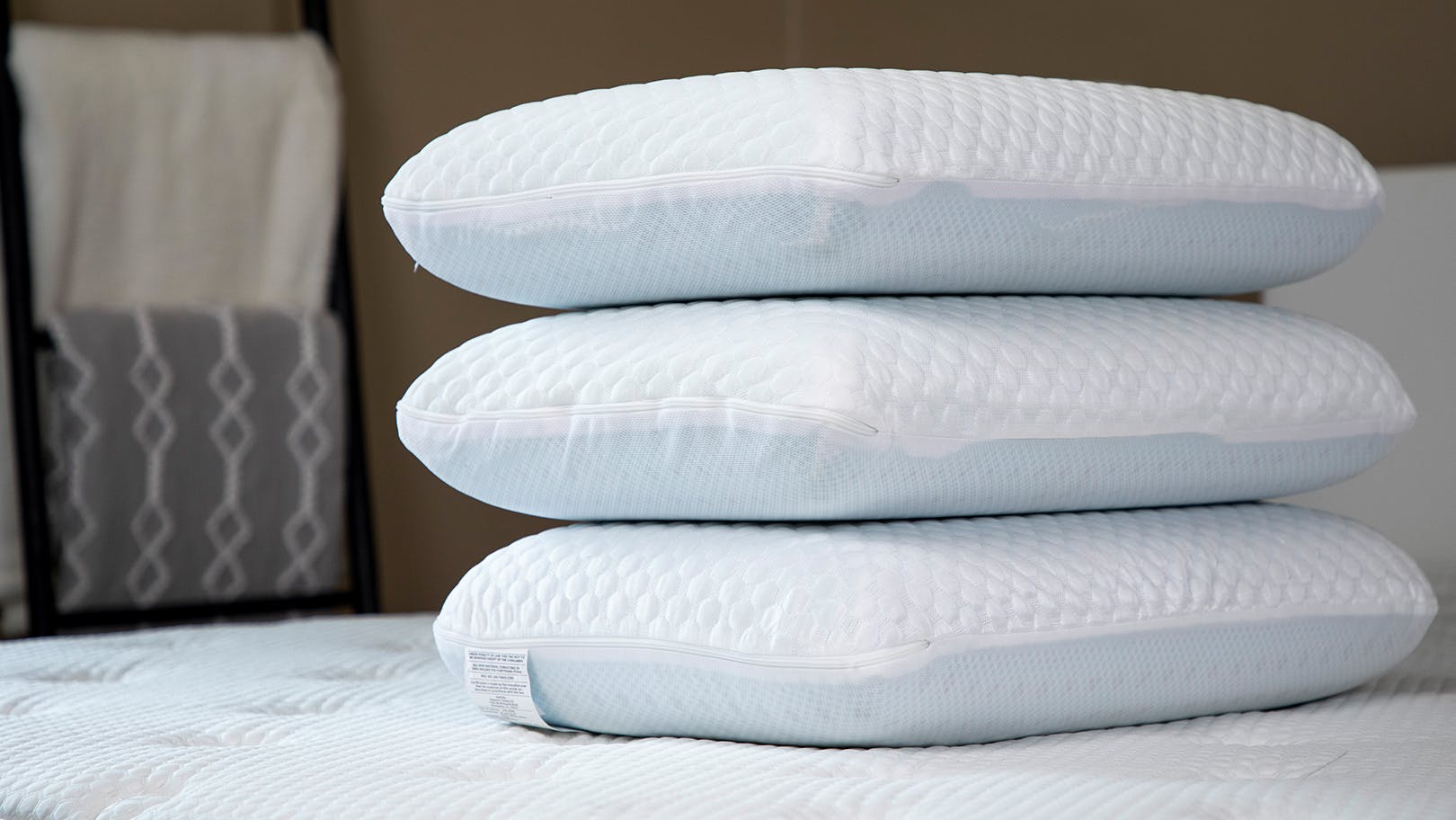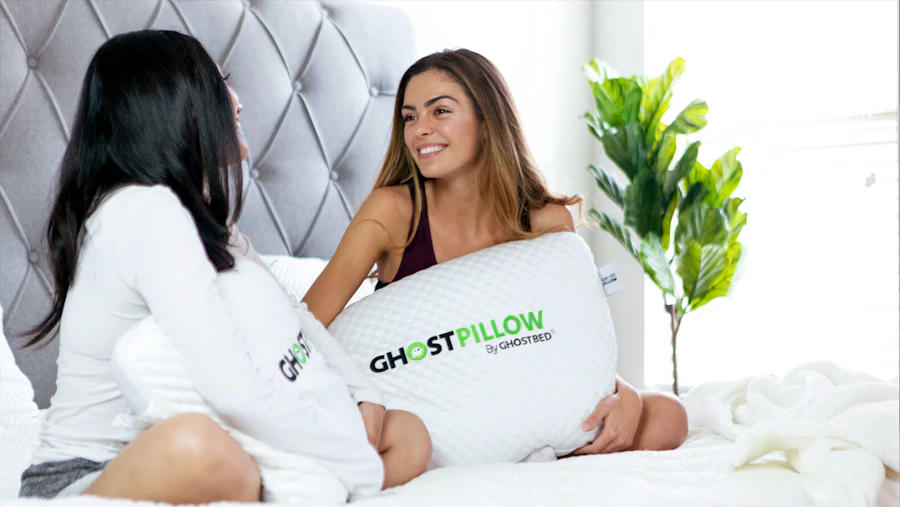How to Wash Any Pillow: A Simple Guide
Last Updated on November 23, 2025
by Marc Werner, Founder - GhostBed

You probably know how important it is to wash your bedding regularly, but have you ever thought about your pillow?
Dirt, oil, sweat, and saliva can build up on your pillow–even if you have a pillowcase protecting it. This contributes to the pillow breaking down over time, resulting in a floppy and unsupportive shape.
While different types of pillows require different cleaning techniques to keep them fresh, you can wash most types easily at home. No dry cleaning required. Keep reading and we’ll share what you need to know to keep your pillows clean.
Overview: Can You Wash Pillows at Home?
While you should always check the labels on your pillows for special instructions, you can easily wash most pillows at home! However, there are a few differences depending on the type of pillow:
- Memory foam pillows: Spot clean only and air dry
- Cotton and feather pillows: Machine washable; wash on gentle in cool or warm water
- Wool pillows: Machine washable; wash on gentle in cool or warm water
- Buckwheat pillows: Wash cover only; remove buckwheat hulls and set aside
- Microbead & gel pillows: Machine washable; wash in cool water in a gentle cycle with a mild detergent

Next question: can pillows be put in the washing machine? It depends on the type of pillow you have. As you’ll see in the sections below, certain pillows—including memory foam pillows—shouldn’t be submerged in water, so you don’t want to put them in your washing machine. Other types, like cotton and faux down, can easily be thrown in the wash.
Another common question people ask is: how often should you wash your pillows? A general rule of thumb is to wash your pillows about every four months or so. This will help address the dirt and oil buildup and maintain the shape and performance of your pillow.
Lastly, what about fluffing? It’s a good idea to fluff your pillows every day when you make your bed. After washing or spot cleaning, give your pillow a more thorough fluffing (more on this later).
How to Clean Memory Foam Pillows

Now, we’ll tackle how to clean specific types of pillows. First up, can you wash memory foam pillows? The answer is yes, but they require a bit of special care. Memory foam pillows–including the GhostPillow - Shredded and GhostPillow - Gel Memory Foam–cannot be placed in a washing machine and should never be fully submerged in water. A washing machine might shred and damage the material, and a dryer might melt the foam. Here’s the right way to wash your memory foam pillow instead:
Step 1: Remove & Wash Your Pillowcase
Remove your pillowcase and wash it. Most can be easily washed in your machine, but make sure to check the label. Some types, like silk pillowcases, have special care instructions to follow.
If your pillow has a protected scrim or inner cover, remove this carefully. This cover can be hand washed in a sink using mild detergent.
Step 2: Spot Clean
Identify the areas that need to be cleaned. Dampen a clean cloth with water and add a small amount of mild detergent. Lightly rub the area, pressing in gently to penetrate the stain.
Wet a second clean cloth completely and wring out almost all the water. Place the moist cloth over the area you just cleaned and press it into the pillow firmly. The clean, moist cloth works to “pull out” the detergent and the stain; you may need to repeat the process a few times.
Step 3: Air Dry
Air drying is imperative for the memory foam to dry properly. A machine dryer may cause damage to the pillow.
Instead, firmly press a clean, dry towel onto the treated area. Continue this process, rotating the towel as needed, until the area is as dry as possible. Let the pillow stay uncovered in a well-ventilated area so it can dry out completely. This is very important to prevent mold.
How to Clean Faux Down Pillows
If you’ve purchased a GhostPillow-Faux Down or any other faux down pillow, you’ll be glad to know it’s easy to clean!
Step 1: Place in Washing Machine
Your faux down pillow can go right in the washing machine. Wash in cool water with mild detergent.
Step 2: Place in Dryer
Your pillow can go directly in the dryer on the gentle cycle. Try adding a tennis ball to the dryer to help fluff your pillow as it dries.
How to Clean Cotton and Feather Pillows
Cotton and feather pillows are just as easy to clean. In fact, they’re probably the easiest types to wash and dry, because you can throw them right into your washing machine.
Step 1: Wash on Gentle
Remove your pillowcase, cover, and/or protector. You will wash these separately with your sheets before placing them back on the clean pillows. Set your washing machine to a gentle cycle with warm water and add a gentle liquid detergent. As the water fills, place up to two pillows into the drum. Be careful not to overload your washer.
Step 2: Complete an Extra Rinse Cycle
Before putting your pillows in the dryer, make sure that all the detergent has been rinsed out. We recommend running the pillows through for an extra rinse cycle to be sure. Once the rinse cycle is over, run two spin cycles to get rid of all excess water.
Step 3: Dry
Drying cotton and fiberfill pillows in a dryer is perfectly fine. For extra-fluffy pillows, toss a tennis ball or two into the dryer as well. Set on low to medium heat for 30 minutes to start. Every 30 minutes, check your pillows for dampness, especially deep in the center. Fluff the pillow(s) and repeat the drying time until fully dry.
How to Clean Wool Pillows

Cleaning wool pillows is also very easy, as you’ll see in the steps below! However, you’ll want to make sure your washing machine is large enough so that water can flow around and through the pillow. If it is, follow the steps below.
Step 1: Wash on Gentle
Add gentle liquid detergent and place on a delicate cold wash and rinse cycle.
Step 2: Combo Air Dry and Low Temperature Dryer
Hang the pillow to line dry for about four hours. Once the pillow is almost dry, place it in your dryer at a low temperature to finish drying and allow it to fluff up.
How to Clean Buckwheat Pillows
When you clean a buckwheat pillow, you won’t be cleaning the actual buckwheat. Once buckwheat hulls are soaked they will be ruined, making them soggy, unsupportive, and a breeding ground for mold. Instead, you’ll simply wash the pillow’s cover.
Step 1: Remove Filling and Wash Cover
Unzip the cover and place buckwheat filling in a large container. Machine wash the cover in cold water with a liquid detergent. While the cover is being washed, sift through the buckwheat to make sure that all the hulls are in good shape. If there are any damp ones you may want to discard them. You can always buy and add new buckwheat if you need it.
Step 2: Air Dry
Air-dry the cover, preferably on a drying rack in the sun. While the cover is drying, place the container of buckwheat in the sun as well. Stir up the hulls during the drying process to cycle the bottom ones to the top.
Step 3: Replace Hulls
Once the cover is completely dry, pour or scoop the buckwheat hulls back inside and zip it up.
How to Clean Microbead & Gel Pillows
Pillows with microfiber gel and/or beads give you that huggable, squeezable feel you crave—much like a down pillow—without the high price point or allergy potential.
Step 1: Wash on Gentle
Wash the pillow in cool water in a gentle cycle with a mild detergent. If your pillow is made with microbeads, it’s a good idea to place it into a large, tied-up pillowcase. This way, the loose beads will be contained if the pillow has any rips or tears in it that you didn’t notice before.
Step 2: Dry on Gentle
Dry the pillow in a dryer on the low temperature setting, along with a tennis ball to help the pillow fluff back up.
Microbead pillows should be taken out of the dryer before they’re completely dry to avoid overheating that might damage the beads; air dry or line dry the rest of the way.
A High-Quality, Easy-Care Pillow
Sometimes high quality products can be a pain to maintain, but we’ve designed every pillow in the GhostPillow line to be easy to wash and care for. That way, you can keep your pillow for years to come and continue getting the best sleep of your life.
If you have questions about which pillow is right for you, our Sleep Experts are standing by to help. Send us a chat to get started.
Marc has spent the last two decades designing & manufacturing mattresses and other sleep products, drawing on a lifetime of experience working with the material sciences. With several patents to his name, he works closely with the GhostBed team to create products with the perfect balance of comfort & support. Learn More

